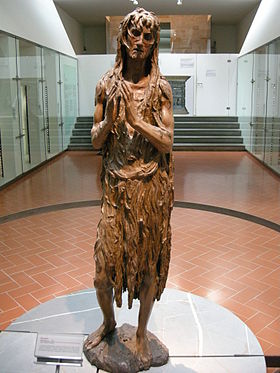
David is a masterpiece of Italian Renaissance sculpture, created from 1501 to 1504 by Michelangelo. With a height of 5.17 metres, the David was the first colossal marble statue made in the early modern period following classical antiquity, a precedent for the 16th century and beyond. David was originally commissioned as one of a series of statues of twelve prophets to be positioned along the roofline of the east end of Florence Cathedral, but was instead placed in the public square in front of the Palazzo della Signoria, the seat of civic government in Florence, where it was unveiled on 8 September 1504. In 1873, the statue was moved to the Galleria dell'Accademia, Florence, and in 1910 replaced at the original location by a replica.

Donato di Niccolò di Betto Bardi, known mononymously as Donatello, was an Italian sculptor of the Renaissance period. Born in Florence, he studied classical sculpture and used his knowledge to develop an Early Renaissance style of sculpture. He spent time in other cities, where he worked on commissions and taught others; his periods in Rome, Padua, and Siena introduced to other parts of Italy the techniques he had developed in the course of a long and productive career. His David was the first freestanding nude male sculpture since antiquity; like much of his work it was commissioned by the Medici family.
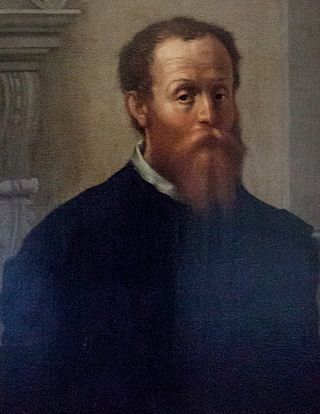
Baccio Bandinelli, was an Italian Renaissance sculptor, draughtsman, and painter.
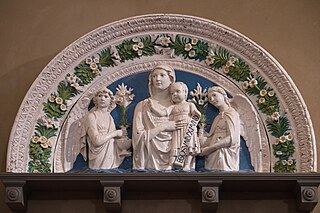
Luca della Robbia was an Italian Renaissance sculptor from Florence. Della Robbia is noted for his colorful, tin-glazed terracotta statuary, a technique that he invented and passed on to his nephew Andrea della Robbia and great-nephews Giovanni della Robbia and Girolamo della Robbia. Although a leading sculptor in stone, after developing his technique in the early 1440s he worked primarily in terracotta. His large workshop produced both less expensive works cast from molds in multiple versions, and more expensive one-off individually modeled pieces.

Jacopo della Quercia, also known as Jacopo di Pietro d'Agnolo di Guarnieri, was an Italian sculptor of the Renaissance, a contemporary of Brunelleschi, Ghiberti and Donatello. He is considered a precursor of Michelangelo.

Florence Cathedral, formally the Cathedral of Saint Mary of the Flower, is the cathedral of Florence, Italy. It was begun in 1296 in the Gothic style to a design of Arnolfo di Cambio and was structurally completed by 1436, with the dome engineered by Filippo Brunelleschi. The exterior of the basilica is faced with polychrome marble panels in various shades of green and pink, bordered by white, and has an elaborate 19th-century Gothic Revival façade by Emilio De Fabris.

David is the title of two statues of the biblical hero by the Italian Early Renaissance sculptor Donatello. They consist of an early work in marble of a clothed figure (1408–09), and a far more famous bronze figure that is nude except for helmet and boots, and dates to the 1440s or later. Both are now in the Museo Nazionale del Bargello in Florence. The first was Donatello's most important commission up to that point, and had a religious context, placed on Florence Cathedral. The bronze remains his most famous work, and was made for a secular context, commissioned by the Medici family.
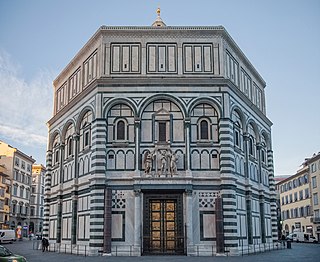
The Florence Baptistery, also known as the Baptistery of Saint John, is a religious building in Florence, Italy, and has the status of a minor basilica. The octagonal baptistery stands in both the Piazza del Duomo and the Piazza San Giovanni, across from Florence Cathedral and the Campanile di Giotto.
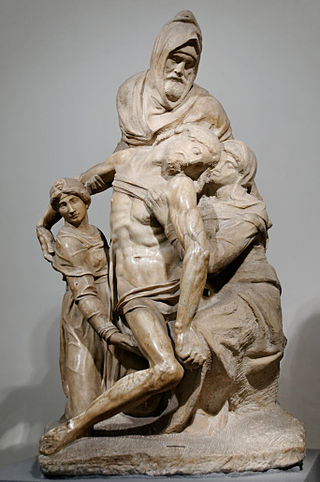
The Deposition is a marble sculpture by the Italian High Renaissance master Michelangelo. The sculpture, on which Michelangelo worked between 1547 and 1555, depicts four figures: the dead body of Jesus Christ, newly taken down from the Cross, Nicodemus, Mary Magdalene and the Virgin Mary. The sculpture is housed in the Museo dell'Opera del Duomo in Florence and is therefore also known as the Florentine Pietà.
The decade of the 1450s in art involved many significant events, especially in sculpture.
Pagno di Lapo Portigiani was an Italian Renaissance decorative sculptor, a minor follower of Donatello who worked on numerous occasions in projects designed and supervised by Michelozzo.

Benedetto Buglioni (1459/1460–1521) was an important Italian Renaissance sculptor specialised in glazed terracotta.

The Museo dell'Opera del Duomo in Florence, Italy is a museum containing many of the original works of art created for Florence Cathedral, including the adjacent Florence Baptistery and Giotto's Campanile. Most of the exterior sculptures have been removed from these cathedral buildings, usually replaced by replica pieces, with the museum conserving the originals.

Lo Zuccone, which translates from Italian as "large head" or "bald head", is the popular name given to a marble statue by Donatello. It was commissioned for the bell tower of the Cathedral of Florence, Italy and completed between 1423 and 1425. It is also known as the Statue of the Prophet Habakkuk, as many believe it depicts the Biblical figure Habakkuk, though Vasari says that it is a portrait of Giovanni di Barduccio Cherichini.

The Feast of Herod is a bronze relief sculpture created by Donatello circa 1427. It was made for the font of the Siena Baptistery of San Giovanni in Italy. It is one of Donatello's earliest relief sculptures, and his first bronze relief. The sculpture is noted for Donatello's use of perspective. The piece is 60 by 61 centimeters.

Stiacciato (Tuscan) or schiacciato is a technique where a sculptor creates a very shallow relief sculpture with carving only millimetres deep. The rilievo stiacciato is primarily associated with Donatello (1386–1466).

Saint Louis of Toulouse is a gilded bronze sculpture of Louis of Toulouse by Donatello with a marble niche all'antica on the facade of Orsanmichele, executed in 1423–1425. It is now in the refectory of the Museo di Santa Croce in Florence.

The Santa Croce Crucifix is a polychrome wood sculpture by Donatello, perhaps from c.1406-1408, or 1409–10. If the former is the correct dating, then Donatello was a young artist working in Lorenzo Ghiberti's workshop and beginning to get his own commissions. It is now in the Cappella Bardi di Vernio, just off the left transept of Santa Croce in Florence, Italy.

Italian Renaissance sculpture was an important part of the art of the Italian Renaissance, in the early stages arguably representing the leading edge. The example of Ancient Roman sculpture hung very heavily over it, both in terms of style and the uses to which sculpture was put. In complete contrast to painting, there were many surviving Roman sculptures around Italy, above all in Rome, and new ones were being excavated all the time, and keenly collected. Apart from a handful of major figures, especially Michelangelo and Donatello, it is today less well-known than Italian Renaissance painting, but this was not the case at the time.

Nanni di Bartolo, also known as "il Rosso", was a Florentine sculptor of the Early Renaissance, a slightly younger contemporary of Donatello. His dates of birth and death are not known, but he is recorded as an active master from 1419 to 1451.
